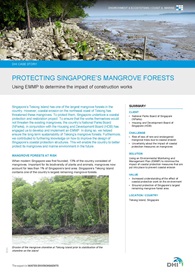Tekong EMMP – protecting the mangroves on Singapore’s Tekong Island
In order to help protect the mangroves of Singapore’s Tekong Island from coastal erosion, we conducted a comprehensive Environmental Monitoring and Management Project (EMMP).
 In order to help protect the mangroves of Singapore’s Tekong Island from coastal erosion, we conducted a comprehensive Environmental Monitoring and Management Project (EMMP). In so doing, we helped ensure the long-term sustainability of Tekong’s mangrove forests.
In order to help protect the mangroves of Singapore’s Tekong Island from coastal erosion, we conducted a comprehensive Environmental Monitoring and Management Project (EMMP). In so doing, we helped ensure the long-term sustainability of Tekong’s mangrove forests.
Singapore’s Tekong Island contains one of the country’s largest remaining mangrove forests. However, the island’s northeast coast suffers from coastal erosion, threatening the mangroves there. To address this, Singapore’s National Parks Board (NParks) is implementing coastal protection and restoration works in the area.
However, the coastal protection measures could themselves have a negative impact on the existing mangroves and the environment. To protect the environment, Singapore’s NParks and Housing Development Board (HDB) asked us to devise and implement an EMMP.
As part of the EMMP, we modelled the shoreline, monitored the growth and survival of planted mangrove seedlings and identified a large amount of natural regeneration of mangrove seedlings during our monitoring.
By applying such a wide-ranging EMMP, we helped ensure that the coastal protection measures were sustainable and would not negatively impact Tekong Island’s marine environment. Furthermore, we contributed to furthering knowledge on how to improve the design of Singapore’s coastal protection structures. This will enable the country to better protect its mangroves and marine environment in the future.
Read more